Sub-replacement fertility
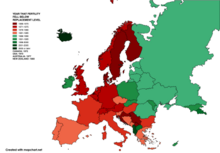
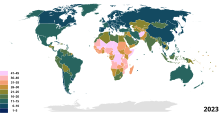
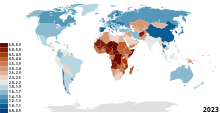
Sub-replacement fertility is a total fertility rate (TFR) that (if sustained) leads to each new generation being less populous than the older, previous one in a given area. The United Nations Population Division defines sub-replacement fertility as any rate below approximately 2.1 children born per woman of childbearing age, but the threshold can be as high as 3.4 in some developing countries because of higher mortality rates.[1] Taken globally, the total fertility rate at replacement was 2.33 children per woman in 2003.[1] This can be "translated" as 2 children per woman to replace the parents, plus a "third of a child" to make up for the higher probability of males born and mortality prior to the end of a person's fertile life.[a] In 2020, the global average fertility rate was around 2.4 children born per woman.[2]
Replacement-level fertility in terms of the net reproduction rate (NRR) is exactly one, because the NRR takes both mortality rates and sex ratios at birth into account.
As of 2010, about 48% (3.3 billion people) of the world population lives in nations with sub-replacement fertility.[3] Nonetheless most of these countries still have growing populations due to immigration, population momentum and increase of the life expectancy. This includes most nations of Europe, Canada, Australia, Brazil, Russia, Iran, Tunisia, China, India, the United States and many others. In 2016, all European Union countries had a sub-replacement fertility rate, ranging from a low of 1.3 in Portugal, Poland, Greece, Spain and Cyprus to a high of 2.0 in France.[4] The countries or areas that have the lowest fertility are in developed parts of East and Southeast Asia: Singapore, Hong Kong and South Korea.[4] Only a few countries have had, for the time being, sufficiently sustained sub-replacement fertility (sometimes combined with other population factors like higher emigration than immigration) to have population decline, such as Japan, Germany, Lithuania, and Ukraine. As of 2020, the total fertility rate varied from 0.84 in South Korea[5] to 7.0 in Niger.[6]
Causes
[edit]Higher education
[edit]
The fact that more people are going to colleges and universities, and are working to obtain more post-graduate degrees there, along with the soaring costs of education, have contributed greatly to postponing marriage in many cases, and bearing children at all, or fewer numbers of children, and the fact that the number of women getting higher education has increased has contributed to fewer of them getting married younger, if at all. In the US, for example, females make up more than half of all college students, which is a reversal from a few decades back.[7]
The relationship between higher education and childbearing varies by country: for example, in Switzerland by age 40, childlessness among women who had completed tertiary education is 40%, while in France it is only 15%.[8] In some countries, childlessness has a longer tradition, and was common even before educational levels increased, but in others, such as Southern European ones, it is a recent phenomenon; for instance in Spain the childlessness rate for women aged 40–44 in 2011 was 21.60%,[9] but historically throughout the 20th century it was around 10%.[8] Not all countries show a relationship between low fertility and education: in Czech Republic, of women born in 1961–1965, low educated women were more likely to be childless than high educated women.[10] In the United States in 2022, women between the ages of 15 and 50 with a graduate or professional degree had the highest birthrate (62 births per 1,000 women), whereas women between the ages of 15 to 50 with less than a high school graduate had the lowest birthrate (32 births per 1,000 women) among all levels of educational attainment of the mother.[11]
A general trade-off
[edit]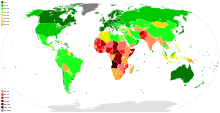
People are more likely in modern society to invest strongly in the needs of their children, such as offering them the best education, shelter (a room only for the child), travel, cultural activities etc. In the past, when child mortality was high, people had more children, but invested less in them. Today, parents usually experience much less doubt about whether the child will live to adulthood, and so are more likely to strongly invest in that child. But strongly investing in each child makes it irrational to have a large numbers of children—this is a "quantity vs. quality trade-off"—with education as the most important such qualitative investment.[12]
Economic fluctuation
[edit]The growth of wealth and human development are related to sub-replacement fertility, although a sudden drop in living conditions, such as the Great Depression, can also lower fertility.[13]
In Eastern European countries, the fall of communism was followed by an economic collapse in many of these countries in the 1990s. Some countries, such as those that experienced violent conflicts in the 1990s, were badly affected. Large numbers of people lost their jobs, and massive unemployment, lack of jobs outside the big cities, and economic uncertainty discourages people from having children.[14] For instance, in Bosnia-Herzegovina, the total fertility rate in 2016 was only 1.28 children born/woman.[15]
Financial challenges such as increased housing prices, concern about job security, cost of raising childern (child care, education cost) have also impact on TFR.[16]
Urbanization
[edit]Some consider the increase of urbanization around the world a central cause. In recent times, residents of urban areas tend to have fewer children than people in rural areas.[17][18] The need for extra labour from children on farms does not apply to urban-dwellers. Cities tend to have higher property prices, making a large family more expensive, especially in those societies where each child is now expected to have their own bedroom, rather than sharing with siblings as was the case until recently. Rural areas also tend to be more conservative, with less contraception and abortion than urban areas.[citation needed]
Reduction in child labour
[edit]
Countries which have a high fertility rate are usually less developed countries, where families rely on children to help them, with labour such as agricultural work, tending to livestock, or even paid work. In such countries child labour is quite common, with children bringing money home, or directly supporting the family through physical work. By contrast, in high-income nations, child labour is almost universally banned, and it is the parents who are expected to invest extensively into their children.[19]
Views on the "ideal" family
[edit]Although fertility rates are often discussed in terms of state policies (e.g. financial benefits, combining work with family etc.), the deeply entrenched social views on what constitutes an "ideal" family may play a crucial role: if parents do not envision large families in a positive way, it is difficult to "convince" them to have many children. In this regard, there are major differences between European countries: while 50.23% of women aged 15–39 state that the "ideal" family has 3 or more children in Estonia, and 46.43% say this in Finland; only 11.3% say this in Czech Republic, and 11.39% in Bulgaria.[20]
Contraception
[edit]Changes in contraception are also an important cause, and one that has seen dramatic changes in the last few generations. Legalization and widespread acceptance of contraception in the developed world is a large factor in decreased fertility levels; however, for instance in a European context where its prevalence has always been very high in the modern era, the fertility rates do not seem to be influenced significantly by availability of contraception.[21]
While contraception can reduce the number of unwanted births and contribute to a smaller ideal family size, contraception does not start fertility reductions nor substantially affect their size, with these being attributable to other factors.[22]
Assisted reproductive technology
[edit]The availability of assisted reproductive technology (ART) may foster delay of childbearing, because many couples think that it can solve any future fertility problems.[21] Its effect on total fertility rate is extremely small but government support for it is beneficial for families.[21]
Human Development Index
[edit]
Very High High Medium | Low Data unavailable |
The Human Development Index (HDI) is a composite statistic of life expectancy, education, and per capita income indicators, which are used to rank countries into four tiers of human development. A country scores higher HDI when the lifespan is higher, the education level is higher, and the GDP per capita is higher. There is a strong inverse correlation between the HDI and the fertility rate of the population: the higher the HDI, the lower the fertility rate. As of 2016, the countries with the highest fertility rate are Burundi, Mali, Somalia, Uganda, Burkina Faso, Zambia, Malawi, Angola, and Afghanistan; while most high-income countries have sub-replacement fertility rates.[4] This is part of the fertility-income paradox, as these high fertility countries are very poor, and it may seem counter-intuitive for families there to have so many children. The inverse relationship between income and fertility has been termed a demographic-economic "paradox" by the notion that greater means would enable the production of more offspring as suggested by the influential Thomas Malthus.[citation needed]
Government policies
[edit]
Some governments have launched programmes to reduce fertility rates and curb population growth. The People's Republic of China implemented a one-child policy for 35 years (from 1979 to 2015); this was relaxed to a two-child policy in 2016 and relaxed further to a three child policy in 2021.[citation needed]
Although today Singapore has a low fertility rate, and the government encourages parents to have more children because birth rates have fallen below the replacement rate, in the 1970s the situation was the opposite: the government wished to slow and reverse the boom in births that started after World War II.[citation needed]
Ability to choose
[edit]The total fertility rate is also influenced by the ability to choose what type of family to have, if and when to have children, and the number of children to have - free from coercion, pressure, or interference from the community, extended family, state or church. This includes prohibition on practices such as child marriage, forced marriage or bride price. In some cultures for instance, the payment of the bride price creates an obligation on the wife to have children, and failure to do so often results in threats and violence.[23] High-income countries have substantially lower fertility rates, and increased childlessness, because people who remain childless or who have small families are less likely to be stigmatized. In many cultures childless women suffer discrimination, stigma, ostracism, and social isolation.[24]
Tempo effect
[edit]This section provides insufficient context for those unfamiliar with the subject. (July 2019) |

Total fertility rate (TFR) is affected by a phenomenon called the tempo effect, which describes "distortions due to changes in the timing of births."[25] John Bongaarts and Griffith Feeney have suggested that this tempo effect is driving the decline of measured fertility rate in the developed world.[26] Specifically, the trend in developed countries of having children at later ages can cause the TFR to be underestimated.[27] For example, as measured by the Human Fertility Database, the United States tempo-adjusted TFR was over a 2.1 replacement level between 1992 and 2015.[28]
Type of partnership
[edit]A study of the United States and multiple countries in Europe came to the result that women who continue to cohabit rather than get married after birth have significantly lower probability of having a second child than married women in all countries except those in Eastern Europe.[29] Another study, on the contrary, came to the result that cohabiting couples in France have equal fertility as married ones.[30]
A large survey in the United States came to the result that married women had an average of 1.9 children, compared to 1.3 among those cohabiting. The corresponding numbers for men were 1.7 and 1.1, respectively. The difference of 0.6 children for both sexes was expected to decrease to between 0.2 and 0.3 over the lifetime when correcting for the confounder that married people have their children earlier in life.[31] In the United States, those who cohabit without marrying had increased fertility when the male earns considerably more than the female.[32]
Gender expectations and norms
[edit]Social norms both within the family and in society at large determine fertility levels. The quality of couple relations in terms of support given to the woman matters, with studies on fertility in the high-income world showing a U-shaped relationship between gender equity within the couple and fertility: in countries with very low fertility rates, the probability of a woman to have the second child occurs at the extremes - either very low gender equality or very high gender equality.[33] This is also reflected at a social level: countries that are neither sufficiently patriarchal to coerce women into having large families, nor sufficiently egalitarian to incentivize women to have more children through strong support (such as subsidized childcare and good support of working mothers), have very low fertility rates, especially among educated women. Where women are expected to 'choose' between their professional and public life, or having children, the more educated the woman is, the more likely she is to choose the former. The strong emphasis on the domestic role of women in Germany (unlike Scandinavia and France) was described as the cause of the very low fertility in that country.[34][35][36]
Historical effects
[edit]The Greek historian Polybius largely blamed the decline of the Hellenistic world on low fertility rates,[37] writing in his work The Histories that:
In our time all Greece was visited by a dearth of children and generally a decay of population, owing to which the cities were denuded of inhabitants, and a failure of productiveness resulted, though there were no long-continued wars or serious pestilences among us.... For this evil grew upon us rapidly, and without attracting attention, by our men becoming perverted to a passion for show and money and the pleasures of an idle life, and accordingly either not marrying at all, or, if they did marry, refusing to rear the children that were born, or at most one or two out of a great number, for the sake of leaving them well off or bringing them up in extravagant luxury.[38]
In a speech to Roman nobles, the Emperor Augustus commented on the low birthrates of the Roman elite:[39][verification needed][full citation needed]
We liberate slaves chiefly for the purpose of making out of them as many citizens as possible. We give our allies a share in the government that our numbers may increase; yet you, Romans of the original stock, including Quintii, Valerii, Iulii, are eager that your families and names at once shall perish with you.[40]
Upon the establishment of the Roman Empire, Emperor Augustus would introduce legislation to increase the birthrates of the Roman nobility.[41]
Some believe that not only the Great Recession, but the Great Depression, may have been the result of a decline in birthrates overall. Clarence L. Barber, an economist at the University of Manitoba, pointed out how demand for housing in the US, for example, began to decline in 1926, due to a decline in 'household formation' (marriage), due, he believed, to the effects of World War I upon society. In early 1929, US housing demand declined precipitously and the stock market crash followed in October of that same year.[42]
Attempts to increase the fertility rate
[edit]There have been several historical attempts to increase the fertility rate via natalist policies that attempt to encourage women to have more children. Upon the establishment of the Roman Empire, Caesar Augustus introduced legislation designed to increase the birthrate.[43][44] Men aged 20 to 60 and women aged 20 to 50 were legally obliged to marry, and widowed or divorced individuals within the relevant age range were required to remarry. Exemptions were granted to those who had already had three children in the case of free-born people and four in the case of freed slaves. For political or bureaucratic office, preference was given to those with at least three legitimate children. Diminished inheritance rights awaited those who failed to reproduce.[44]
In modern times, one of the most forceful attempts to increase the TFR occurred in Communist Romania between 1967 and 1990. Communist leader Nicolae Ceaușescu adopted a very aggressive natalist policy that included outlawing abortion and contraception, routine pregnancy tests for women, taxes on childlessness, and legal discrimination against childless people. This period was depicted in movies and documentaries (such as 4 Months, 3 Weeks and 2 Days, Children of the Decree). These policies increased birth rates during the period of policy implementation, but was followed by a decline due to increased illegal abortion.[45][46] Ceaușescu's policy resulted in over 9,000 women who died due to illegal abortions,[47] large numbers of children put into orphanages by parents who could not cope with raising them, street children in the 1990s (when many orphanages were closed and the children ended up on the streets), and overcrowding in homes and schools. In addition, Ceaușescu's demographic policies are feared of having very serious effects in the future, because the generations born under Ceaușescu are large (especially the late 1960s and the 1970s), while those born in the 1990s and 2000s are very small. This is believed to cause a very serious demographic shock when the former generations retire, as there will be insufficient young people in the workforce to support the elderly.[48][49][50] Apart from Romania, a relatively similar policy of restricted reproductive rights during that period also existed in Communist Albania, under Enver Hoxha (see Abortion in Albania).
At present, many governments provide financial incentives to have more children. These include tax allowances for working parents, improving child-care provision, reducing working hours/weekend working in female-dominated professions such as healthcare and a stricter enforcement of anti-discrimination measures to prevent professional women's promotion prospects being hindered when they take time off work to care for children. In 2002, Australia introduced a Baby Bonus that did increase birth rates in the years immediately after. The fertility rate also increased to around 2.0 in France and 1.9 in Britain and some other northern European countries, but the role of population policies in these trends is debated.[51] In Italy, for example, natalist policies may have actually discouraged the Italian population from having more children. This "widespread resistance" was the result of the Italian government, at one point,[when?] taxing single persons and criminalizing abortion and even contraception.[52]
European analysts[who?] hope, with the help of government incentives and large-scale change towards family-friendly policies, to stall the population decline and reverse it by around 2030, expecting that most of Europe will have a slight natural increase by then.[citation needed] C. D. Howe Institute, for example, tries to demonstrate that immigration cannot be used to effectively counter population ageing.[53]
Current effects
[edit]Population aging may pose an economic challenge to governments as the number of retired citizens drawing public pensions rises in relation to the number of workers. This has been raised as a political issue in France, Germany, and the United States where many people have advocated policy changes to encourage higher birth and immigration rates.[citation needed]
Analysing data for 40 countries, Lee et al. show that typically fertility well above replacement and population growth would be most beneficial for government budgets. Fertility near replacement and population stability, however, would be most beneficial for standards of living when the analysis includes the effects of age structure on families as well as governments. Fertility moderately below replacement and population decline would maximize standards of living when the cost of providing capital for a growing labour force is taken into account.[54]
Forecasts
[edit]This section needs additional citations for verification. (January 2009) |
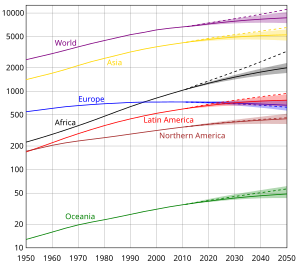
Note the vertical axis is logarithmic and represents millions of people.
Sub-replacement fertility does not automatically translate into a population decline because of increasing life expectancy and population momentum: recently high fertility rates produce a disproportionately young population, and younger populations have higher birth rates. This is why some nations with sub-replacement fertility still have a growing population, because a relatively large fraction of their population are still of child-bearing age. But if the fertility trend is sustained (and not compensated by immigration), it results in population ageing and/or population decline. This is already happening and impacts most of the countries of Europe and East Asia.
Current estimates expect the world's total fertility rate to fall below replacement levels by 2050.[55] There are several projections of population growth after 2050. The UN Population Division projects the world population, which is 7.8 billion as of 2020, to level out around 2100 at 10.9 billion[56][57] A 2020 study published by The Lancet from researchers funded by the Global Burden of Disease Study promotes a lower growth scenario, projecting that world population will peak in 2064 at 9.7 billion and then decline to 8.8 billion in 2100.[58] An analysis from the Wittgenstein Center IIASA predicts global population to peak in 2070 at 9.4 billion and then decline to 9.0 billion in 2100.[59]
Cases of fertility rate increases in individual countries
[edit]United States
[edit]For twenty years, the total fertility rate in the United States remained relatively stable compared to much of the world.[60] However, US TFR declined from 2.12 in 2007 to 1.64 in 2020.[61]
Other developed countries
[edit]Some other developed countries experienced temporary increases in their birth rate in the first decade of the 21st century before seeing TFR steadily decline to all-time lows in the subsequent decade, including France, which recorded a TFR of over 2.00 in 2008,[62] though it has since declined to 1.8 as 2020;[63] the United Kingdom where TFR increased from 1.64 in 2000 to 1.98 in 2010,[64] and then declined to 1.6 in 2020;[65] Australia, where the birth rate rose from 1.73 in 2001[66] to 1.93 in 2007[67] before declining to 1.6 in 2020,[68] and New Zealand, where the TFR was 2.2 in 2008[69] and then declined to 1.6 in 2020.[70]
Israel is the only developed country that has never had sub-replacement fertility; a declining Arab and Bedouin fertility rate is countered by religious Jewish groups (mostly Haredim) with higher than average fertility rates. In addition, the (mostly non-religious)[citation needed] aliyah Jews from the former USSR shifted from a 1 child per woman fertility rate to an average fertility rate close to 2.2 children per woman. As of 2008, Israel's Jewish fertility rate is the highest among the industrial nations.[71]
See also
[edit]- Fertility and intelligence
- Population decline
- Natalism in public policy for attempts at reversing sub-replacement fertility without engaging mass immigration
- Demography
- List of countries and territories by fertility rate
- Zero population growth
- Economic dynamics
Notes
[edit]- ^ For example, in the United Kingdom in 2001, 304,635 boys were born as opposed to 290,000 girls, and some of these girls do not survive to the end of their child-bearing years. In future, therefore, the girls born in this year would have to have more than two children each to replace the total population. For a full explanation see Steve Smallwood & Jessica Chamberlain (Spring 2005). "Replacement Fertility, What has it been and What does it mean?" (PDF). Population Trends. 119: 16–27.
References
[edit]- ^ a b Espenshade TJ, Guzman JC, Westoff CF (2003). "The surprising global variation in replacement fertility". Population Research and Policy Review. 22 (5/6): 575–583. doi:10.1023/B:POPU.0000020882.29684.8e. S2CID 10798893., Introduction and Table 1, p. 580
- ^ "Fertility rate, total (births per woman)". The World Bank.
- ^ "Figure 8: Population by Total Fertility (millions)" in World Population Prospects, the 2010 Revision. United Nations, Department of Economic and Social Affairs, Population Division (2011)
- ^ a b c "Fertility rate, total (births per woman)". The World Bank.
- ^ Esther Chung; Heo Jeong-won (3 January 2021). "Korea marks first-ever decline in registered population". Korea JoongAng Daily.
- ^ "Niger Total fertility rate - Demographics". IndexMundi.
- ^ "NCHS Pressroom - 1997 Fact Sheet - Mothers Education and Birth Rate". Centers for Disease Control and Prevention. 24 April 1997.
- ^ a b "SF2.5: Childlessness" (PDF). Organisation for Economic Co-operation and Development. Archived from the original (PDF) on 14 December 2015. Retrieved 15 February 2017.
- ^ https://www.oecd.org/els/family/SF_2-5-Childlessness.pdf [bare URL PDF]
- ^ http://demografia.hu/hu/letoltes/publikaciok/EPCposter2016.pdf [bare URL PDF]
- ^ "Birth rate by educational attainment of mother U.S. 2022".
- ^ Haoming Liu (May 2015). The quantity–quality fertility–education trade-off (PDF) (Report). IZA World of Labor – via wol.iza.org.
- ^ "Fact Sheet: The Decline in U.S. Fertility". Archived from the original on 8 March 2018. Retrieved 5 February 2017.[full citation needed]
- ^ Pobric, Alma; Robinson, Guy M (2015). "Population ageing and low fertility: Recent demographic changes in Bosnia and Herzegovina". Journal of Population Research. 32: 23–43. doi:10.1007/s12546-014-9141-5. S2CID 154600779.
- ^ "Europe :: Bosnia and Herzegovina". The World Factbook. Central Intelligence Agency. 3 November 2021.
- ^ Society at a Glance 2024: OECD Social Indicators OECD, 20 June 2024
- ^ Ueki T (February 1995). "[Analysis of factors related to the recent decline in birth rate in Japan]". [Nihon Koshu Eisei Zasshi] Japanese Journal of Public Health. 42 (2): 121–8. PMID 7718907.
- ^ Khan HT, Raeside R (February 1997). "Factors affecting the most recent fertility rates in urban-rural Bangladesh". Social Science & Medicine. 44 (3): 279–89. doi:10.1016/s0277-9536(96)00076-7. PMID 9004364.
- ^ https://tad.colman.ac.il/paper-all/9868.pdf [bare URL PDF]
- ^ "OECD Family Database - OECD".
- ^ a b c ESHRE Capri Workshop Group (2010). "Europe the continent with the lowest fertility". Human Reproduction Update. 16 (6): 590–602. doi:10.1093/humupd/dmq023. PMID 20603286.
- ^ Leridon, H., 2006. Demographic effects of the introduction of steroid contraception in developed countries. Human Reproduction Update, 12(5), pp.603-616.
- ^ Bawah, Ayaga Agula; Akweongo, Patricia; Simmons, Ruth; Phillips, James F. (1999). "Women's fears and men's anxieties: the impact of family planning on gender relations in Northern Ghana". Studies in Family Planning. 30 (1): 54–66. doi:10.1111/j.1728-4465.1999.00054.x. hdl:2027.42/73927. PMID 10216896. PDF.
- ^ WHO (December 2010). "Mother or nothing: the agony of infertility". Bulletin of the World Health Organization. 88 (12): 877–953. Archived from the original on 17 March 2014.
- ^ Matthijs, Koenraad; Neels, Karel; Timmerman, Christiane; Haers, Jaques (2015). Population Change in Europe, the Middle-East and North Africa: Beyond the Demographic Divide. Routledge.
- ^ Bongaarts, J. (2002). "The End of the Fertility Transition in the Developed World". Population and Development Review. 28 (3): 419–443. CiteSeerX 10.1.1.533.4803. doi:10.1111/j.1728-4457.2002.00419.x.
- ^ Zeitung, Freisinnige (13 April 2019). "A Short Explanation of the "Tempo Effect". Medium. Retrieved 27 September 2021.
- ^ "Tempo-adjusted TFR". Human Fertility Database. Retrieved 2 September 2024.
- ^ Perelli-Harris B (2014). "How Similar are Cohabiting and Married Parents? Second Conception Risks by Union Type in the United States and Across Europe". European Journal of Population. 30 (4): 437–464. doi:10.1007/s10680-014-9320-2. PMC 4221046. PMID 25395696.
- ^ Balbo N, Billari FC, Mills M (February 2013). "Fertility in Advanced Societies: A Review of Research: La fécondité dans les sociétés avancées: un examen des recherches". European Journal of Population. 29 (1): 1–38. doi:10.1007/s10680-012-9277-y. PMC 3576563. PMID 23440941.
- ^ Gladys Martinez; Kimberly Daniels; Anjani Chandra (2012). "Fertility of Men and Women Aged 15–44 Years in the United States: National Survey of Family Growth, 2006–2010" (PDF). Division of Vital Statistics, National Center for Health Statistics.
- ^ Zhang, Junfu; Song, Xue (December 2007). "Fertility Differences between Married and Cohabiting Couples: A Switching Regression Analysis" (PDF). doi:10.2139/ssrn.1136407. SSRN 1136407.
{{cite journal}}: Cite journal requires|journal=(help) - ^ Balbo N, Billari FC, Mills M (February 2013). "Fertility in Advanced Societies: A Review of Research". European Journal of Population. 29 (1): 1–38. doi:10.1007/s10680-012-9277-y. PMC 3576563. PMID 23440941.
- ^ Kate Connolly (21 September 2012). "Germany's birthrate is the lowest in Europe – and falling fast". The Guardian.
- ^ "Germany passes Japan to have world's lowest birth rate – study". BBC News. 29 May 2015.
- ^ Luke Harding (26 January 2006). "Germany agonises over 30% childless women". The Guardian.
- ^ Polybius. "Depopulation of Greece". Histories. Vol. 37. Tufts. Retrieved 18 February 2016.
{{cite book}}:|website=ignored (help) - ^ Polybius (2012). Evelyn S. Shuckburgh (ed.). The Histories of Polybius: Translated from the Text of F. Hultsch. Translated by Evelyn S. Shuckburgh. Cambridge University Press. p. 510. ISBN 978-1-1080-5079-1. Retrieved 2 November 2013.
- ^ "UNKNOWN". Project Gutenberg. Retrieved 18 February 2016.
- ^ Dio, Cassius (2004). Dio's Rome, Volume 4. Kessinger Publishing. p. 86. ISBN 978-1-4191-1611-7. Retrieved 3 November 2013.
- ^ "Ancient Rome: Administration of Rome and Italy". Encyclopædia Britannica Online. Encyclopædia Britannica, Inc. Retrieved 17 January 2015.
- ^ Gene Smiley. "Chapter 7: What Caused the Great Depression?" (PDF). The American Economy in the 20th Century. Page 7-1. Archived from the original (PDF) on 9 March 2012. Retrieved 18 December 2011 – via QC econ BBA.
Real gross housing expenditures on new units can be separated into two multiplicative components; housing starts and the real average investment per unit. 25 After estimating the determinants of each, Bolch, Fels, and McMahon examined the building hypothesis by simulating what would have been the case in each situation if a "normal" situation had occurred. 26 The result was overbuilding in the number of housing units from 1922 through 1929. They also found "overinvestment" per individual housing unit from 1921 to 1928 and conclude that excessive housing starts relative to family formation led to the sharp decline in housing construction at the end of the twenties. In their view the demographic changes in the twenties were the proximate causes of this. In a 1978 study Clarence Barber was even more emphatic on the importance of demographic changes, suggesting that these were the ultimate explanation of the Great Depression. 27 Basing his explanation on a Harrod-Domar growth model, Barber argues that the rapid decline in the population's growth rate disturbed that equilibrium, and this rapid fall in the natural growth rate initiated the depression.
- ^ "Administration of Rome and Italy". Encyclopædia Britannica. Encyclopædia Britannica, Inc. Retrieved 30 September 2019.
- ^ a b Frank, Richard (1975). "Augustus' Legislation on Marriage and Children". California Studies in Classical Antiquity. 8: 41–52. doi:10.2307/25010681. JSTOR 25010681 – via JSTOR.
- ^ The ESHRE Capri Workshop Group (2010). "Europe the continent with the lowest fertility". Human Reproduction Update. 16 (6): 590–602. doi:10.1093/humupd/dmq023. PMID 20603286.
- ^ Horga M, Gerdts C, Potts M (January 2013). "The remarkable story of Romanian women's struggle to manage their fertility". The Journal of Family Planning and Reproductive Health Care. 39 (1): 2–4. doi:10.1136/jfprhc-2012-100498. PMID 23296845.
- ^ Kligman, Gail (1995). "Political Demography: The Banning of Abortion in Ceausescu's Romania". In Ginsburg, Faye D.; Rapp, Rayna (eds.). Conceiving the New World Order: The Global Politics of Reproduction. Berkeley, CA: University of California Press. pp. 234–255. AIDSLINE KIE/49442.
- ^ "Bomba de peste 20 de ani: Ce se va intampla cand vor iesi la pensie "decreteii", cei 1,7 milioane de romani care sustin economia?".
- ^ "Pensiile "decreţeilor" sunt o bombă cu ceas. Statul le poate plăti 15% din salariu la bătrâneţe".
- ^ "Evenimentul Zilei". Evenimentul Zilei.
- ^ "Suddenly, the old world looks younger". The Economist. 14 June 2007.
- ^ Marchesi M (2012). "Reproducing Italians: contested biopolitics in the age of 'replacement anxiety'". Anthropology & Medicine. 19 (2): 171–88. doi:10.1080/13648470.2012.675043. PMID 22889426. S2CID 21330049.
- ^ Guillemette, Yvan; Robson, William B.P. (September 2006). No Elixir of Youth: Immigration Cannot Keep Canada Young (PDF). Backgrounder (Report). C.D. Howe Institute. Archived from the original (PDF) on 14 April 2008.
- ^ Lee R, Mason A (October 2014). "Is low fertility really a problem? Population aging, dependency, and consumption". Science. 346 (6206): 229–34. Bibcode:2014Sci...346..229L. doi:10.1126/science.1250542. PMC 4545628. PMID 25301626.
- ^ "Population, Health and Human Well-being — Demographics: Total fertility rate (dynamically generated)". EarthTrends. World Resources Institute. Archived from the original on 17 January 2012. Retrieved 13 June 2010.
- ^ "World Population Prospects 2019". United Nations, Dept of Economic and Social Affairs. 2019.
- ^ "World Population Prospects 2019, Population Data, File: Total Population Both Sexes, Medium Variant tab". United Nations Population Division. 2019.
- ^ Vollset, Stein Emil; Goren, Emily; Yuan, Chun-Wei (14 July 2020). "Fertility, mortality, migration, and population scenarios for 195 countries and territories from 2017 to 2100: a forecasting analysis for the Global Burden of Disease Study". Lancet. 396 (10258): 1285–1306. doi:10.1016/S0140-6736(20)30677-2. PMC 7561721. PMID 32679112.
- ^ "Projected world population by level of education". Our World In Data. 2016.
- ^ "Total Fertility Rate of the United States, History plus Forecast". The Frederick S. Pardee Center for International Futures. University of Denver. Archived from the original on 22 February 2014. Retrieved 26 April 2012.
- ^ "Fertility Rate, Total for the United States". FRED, Federal Reserve Bank of St. Louis. 1 January 1960. Retrieved 25 May 2022.
- ^ "Tabc3 Tableau complémentaire 3 : Taux de fécondité par groupe d'âges" (in French). INSEE.
- ^ "Fertility rate, total (births per woman) - France | Data". data.worldbank.org. Retrieved 25 May 2022.
- ^ "Births and Deaths in England and Wales, 2011 (Provisional)". Office for National Statistics. Retrieved 13 January 2013.
- ^ "Fertility rate, total (births per woman) - United Kingdom | Data". data.worldbank.org. Retrieved 25 May 2022.
- ^ "Feature Article 2: Recent Increases in Australia's Fertility". 1301.0 - Year Book Australia, 2008. Australian Bureau of Statistics. 7 February 2008.
- ^ "NOTES". 3301.0 – Births, Australia, 2007. Australian Bureau of Statistics. 28 October 2008. Archived from the original on 29 December 2008.
"Births registered, Summary statistics for Australia(a)". 3301.0 – Births, Australia, 2016. Australian Bureau of Statistics. 13 December 2017. Archived from the original on 30 December 2017. Retrieved 13 September 2018.(a) Includes Other Territories. Births registered on Norfolk Island from 1 July 2016 are included in this publication for the first time.
- ^ "Fertility rate, total (births per woman) - Australia | Data". data.worldbank.org. Retrieved 25 May 2022.
- ^ Collins, Simon (19 February 2009). "Baby boom goes against mothers' advice". The New Zealand Herald. Retrieved 14 November 2011.
- ^ "Fertility rate, total (births per woman) - New Zealand | Data". data.worldbank.org. Retrieved 25 May 2022.
- ^ Yoram Ettinger (25 July 2008). "Demographic Optimism, Not Pessimism". The Washington Jewish Week. Archived from the original on 23 February 2014. Retrieved 13 September 2018 – via The Ettinger Report.
